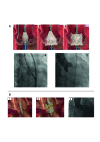Aortic regurgitation: from mechanisms to management
- PMID: 39219357
- PMCID: PMC11352546
- DOI: 10.4244/EIJ-D-23-00840
Aortic regurgitation: from mechanisms to management
Abstract
Aortic regurgitation (AR) is a common clinical disease associated with significant morbidity and mortality. Investigations based largely on non-invasive imaging are pivotal in discerning the severity of disease and its impact on the heart. Advances in technology have contributed to improved risk stratification and to our understanding of the pathophysiology of AR. Surgical aortic valve replacement is the predominant treatment. However, its use is limited to patients with an acceptable surgical risk profile. Transcatheter aortic valve implantation is an alternative treatment. However, this therapy remains in its infancy, and further data and experience are required. This review article on AR describes its prevalence, mechanisms, diagnosis and treatment.
Conflict of interest statement
A. Baumbach has received speaker fees from Abbott, Medtronic, and MicroPort; and has been a proctor for JenaValve. K.P. Patel has received an unrestricted research grant from Edwards Lifesciences. V. Delgado has received speaker fees from Edwards Lifesciences, GE HealthCare, Novartis, and Philips; and has received consulting fees from Edwards Lifesciences, Novo Nordisk, and Merck & Co. T.K. Rudolph has been a proctor and medical advisor for JenaValve; she has received speaker fees from Edwards Lifesciences, Boston Scientific, Medtronic, and JenaValve. H. Treede has been a proctor and advisor for JenaValve. A.R. Tamm has been a proctor for the Trilogy system.
Figures









References
-
- Singh JP, Evans JC, Levy D, Larson MG, Freed LA, Fuller DL, Lehman B, Benjamin EJ. Prevalence and clinical determinants of mitral, tricuspid, and aortic regurgitation (the Framingham Heart Study). Am J Cardiol. 1999;83:897–902. - PubMed
-
- d’Arcy JL, Coffey S, Loudon MA, Kennedy A, Pearson-Stuttard J, Birks J, Frangou E, Farmer AJ, Mant D, Wilson J, Myerson SG, Prendergast BD. Large-scale community echocardiographic screening reveals a major burden of undiagnosed valvular heart disease in older people: the OxVALVE Population Cohort Study. Eur Heart J. 2016;37:3515–22. - PMC - PubMed
-
- Boodhwani M, de Kerchove, Glineur D, Poncelet A, Rubay J, Astarci P, Verhelst R, Noirhomme P, El Khoury. Repair-oriented classification of aortic insufficiency: impact on surgical techniques and clinical outcomes. J Thorac Cardiovasc Surg. 2009;137:286–94. - PubMed
-
- Carpentier A. Cardiac valve surgery--the “French correction”. J Thorac Cardiovasc Surg. 1983;86:323–37. - PubMed
-
- Evangelista A, Sitges M, Jondeau G, Nijveldt R, Pepi M, Cuellar H, Pontone G, Bossone E, Groenink M, Dweck MR, Roos-Hesselink JW, Mazzolai L, van Kimmenade, Aboyans V, Rodríguez-Palomares J. Multimodality imaging in thoracic aortic diseases: a clinical consensus statement from the European Association of Cardiovascular Imaging and the European Society of Cardiology working group on aorta and peripheral vascular diseases. Eur Heart J Cardiovasc Imaging. 2023;24:e65–85. - PubMed
Publication types
MeSH terms
LinkOut - more resources
Full Text Sources
Research Materials

